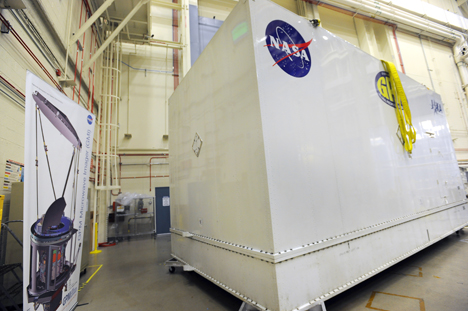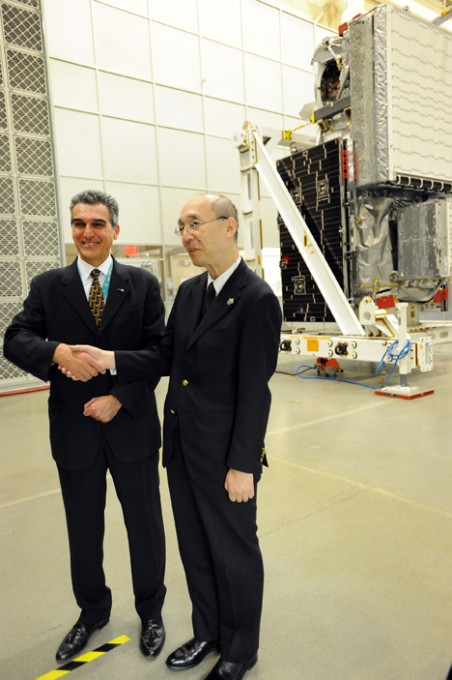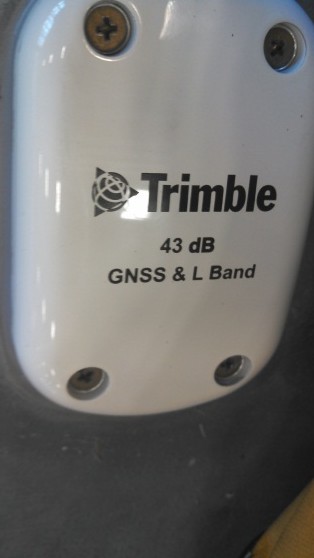


The shipping container that will carry GPM to Japan. Comes complete with environmental regulation to keep the humidity and temperature just right for the spacecraft. Credit: NASA
Right now if you want to take a look at the Global Precipitation Measurement mission’s Core Observatory, you can’t. As of last weekend, it’s sealed up inside a giant white shipping container, all prepped for its long journey to Japan where it will launch in early 2014.
This isn’t your typical satellite delivery. As Project Manager Art Azarbarzin says, we’re not just driving by truck across a couple states to a U.S. launch site. GPM will be traveling by truck to an Air Force C5 cargo plane which will fly it over the United States and the Pacific Ocean to Japan. Once at the airport on Kyushu, it will be transferred to a barge that will take it to Tanegashima Island, where NASA’s mission partners, the Japan Aerospace Exploration Agency, or JAXA, have their spaceport.
My bags are packed too. As the science writer for the GPM mission, I’ll be traveling with the satellite and the engineering team that’s accompanying the spacecraft. getting the behind the scenes story of GPM’s road trip. I’ll be sending back photos and stories of each leg of the journey, and once we arrive, introduce you to living and working Tanegashima, Japan.

NASA’s GPM Project Manager Art Azarbarzin (left) and JAXA’s GPM Project Manager Masahiro Kojima in front of the GPM satellite at its last public appearance on Nov 15, 2013. Credit: NASA
Every satellite’s shipment to the launch site is a big moment, but for GPM it feels especially poignant because the spacecraft was built and tested in-house at Goddard Space Flight Center. Over 300 people worked on it here, and have seen it come together day by day. At our recent Friends and Family Day, the energy of the team was palpable as they shared their excitement for the mission and the satellite they had built together with their loved ones.
For me, the second story I wrote when I began working at Goddard was about testing part of the frame for the body of the GPM spacecraft on Goddard’s high capacity centrifuge. Since then I’ve covered both the engineering milestones and stories about the science GPM will do to improve rain and snowfall measurements from space, as well helped the science team share their work on field campaigns like the Iowa Flood Studies in preparation for GPM’s launch.
That launch is almost here is a little surreal but I’m very excited as we begin this final phase before liftoff. Stay tuned.
In early September, I drove down to Wallops Flight Facility to set up our GPS base station in preparation for the test flight. The test flight is to verify that everything is working as expected, and to do some calibration, since the C-130 is a new platform for the Land, Vegetation, and Ice Sensor (LVIS). LVIS gathers data by sending out short laser beam pulses that bounce off the ground and give us the elevation of the terrain. Calibration ensures that we can pinpoint to within an inch where the laser hits the ground. We need to know exactly where the instrument is, and what it is seeing on the ground.
We use GPS receivers both on the ground and in the plane to track the position of the instrument. That’s where I come in. I set up the GPS ground station, which consists of GPS receivers and an antenna. In the field we usually get a rundown shack and we have to set up our own antenna. The Wallops GPS building was luxurious in comparison. It was spacious, air-conditioned, and had a permanent antenna built in, which meant I didn’t have to set up a tripod. I hooked up three ground receivers to the antenna, verified that they were working and started recording data. We do this for up to five days, in order to calculate precisely the location of the ground antenna.
I also tested the GPS antenna on the plane. It’s a different model from the ground antenna and is bolted to the top of the plane. A cable runs down from it so we can hook up the receivers. Just like for the ground receivers, I verify that they are working and recording data correctly.

GPS antenna aboard the C-130
The C-130 is a rugged cargo plane. One of our instrument racks, filled with equipment necessary to operate LVIS, was sitting on the hangar floor outside the plane, waiting to be moved into place and bolted down. I got a look at the current state of the in-flight facilities and took pictures for the team back home. There had been much discussion on the subject since some of our flights may last up to 10 hours. We never imagined we’d be discussing these issues when we were in school! It’s all part of the field work experience.
At the end of the day, I collected and verified the GPS data available and left the ground receivers running. Everything was working as expected, so it was time for me to make the three hour trek back home. No traffic and beautiful scenery made for a pleasant drive.